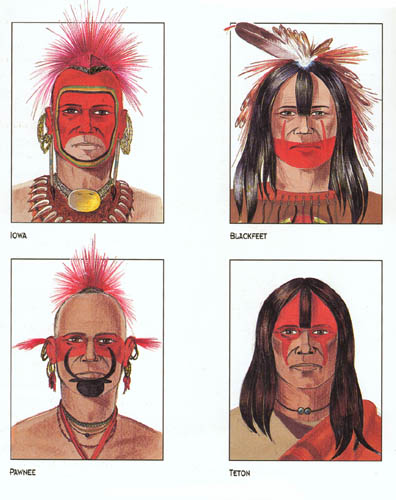|
|
|
The Dhegiha Sioux

|
The Dhegiha Sioux were a group of tribes speaking Siouan languages and living in the Central Plains. The Southern Plains people probably came from the Ohio River Valley around 1500 and included, in the North, the Omaha, Ponca, Osage, and Kansa tribes. The Quapaw were in the South, on the lower Arkansas River. These peoples were both hunters and farmers who grew corn. Tatoos and facial / body painting were common markings of the Plains Warriors and considered protective virtues. It was also used for visual intimidation of enemies. Often the horses were also decorated to reflect his riders' bravery and exploits. |
|
OSAGE In 1802, French traders persuaded them to travel up the Arkansas River and settle in Oklahoma, but they were subjected to a constant stream of other tribes who fleed into Oklahoma by the encroaching Whites. Initailly, they mnoved onto a reservation in Kansas, but settled later in Oklahoma (1870). Numbering 6,200 in 1780, they increased to more than 6,700 by 1985. |
|
PONCA They were conquered by their enemies, the Dakota Sioux and subsequently moved to Oklahoma in 1877. A small group refused to leave their territory and part of it later became a reservation in 1889. Their population was estimated at 800 in 1780. By 1940, there were 401 Ponca in Nebraska and 2,272 in Oklahoma. |
|
OMAHA They had no large-scale wars with the Whites, but were consistently at war with the Dakota Sioux. They sold their land in 1854 except for one parcel in an area taken from the Winnebago - and this later became their reservation. Numbering 2,800 in 1780, they were 1,300 in 1970. |
![]()
Plains Indians
: Intro
The Sioux : Dakota ~
Dhegiha ~ Chiewere ~ Mandan
~ Hidatsa
The Caddo : Arikara
~ Pawnee ~ Wichita
The Shoshonean : Comanche ~ Kiowa
The Alqonquian : Blackfeet ~ Gros Ventre ~ Cheyenne
~ Arapaho ~ Plains Cree ~ Plains Ojibwa
Crazy Horse ~~ Red Cloud ~~ Sitting Bull
![]()
Where We Critters Live
Kaws || Wichitas
|| Plains Indians
Kansas || Wichita
The Infamous || Tornado!
Main
SiteGuide
~~~~~~~~~~~~~~~~~~~~~~~~~~~~~~~~~~~~~~~~~~~